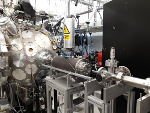| Version 2 (modified by , 4 years ago) ( diff ) |
|---|
LhARA ionacoustic dose profiling meeting: 01Sep21; 09:00 BST
Notes
Present: Jeff Bamber, Ben Cox, Jamie Guggenheim, Ken Long, John Matheson
Apologies: none
- Introduction, notes and actions of previous meeting: KL/All
- None recorded.
- Update on simulation of beam: AMLR, KK, JMcG
- Proposal planning : JB, JM, All
- Next steps--discussion: All
Ken will take over the GEANT simulations as Josie’s placement is coming to an end. The proton-in-water simulations may not include a container so this needs to be added in case it causes reverb of the acoustic signals. Jeff commented that lagging the tank and time gating are among the approaches used to minimise this.
Jeff gave a recap of the last meeting, in which we discussed the GC call; this could be a basis for the current Proposal. A shortened version is on the Wiki, Jeff will circulate the full version.
Jeff suggested that LhARA should aim to address real challenges in the field of ion acoustic imaging:
- How to optimise for weak signals inc. multi-element transducer arrays
- Available transducers most sensitive at high frequency – could tie in with short (10ns) pulses from proton beam
- Utilise the full frequency range of the acoustic signals to get anatomical information and correlate the proton dose maps to anatomy – couple the ion-acoustic imaging to conventional ultrasound imaging techniques
- Microbeams look good for ion acoustic imaging (generate high frequencies) and for radiobiological effectiveness
The ideal transducer array would exploit the max. range of frequencies, from the path of the protons before the Bragg Peak, as well as the peak itself. Ideal arrangement is a sphere with a hole for the beam; this ideally needs a mechanical positioning (translation) capability. A first (cheaper) stage could be a ring array. Similar approaches exist in the literature for breast imaging.
The ultimate development might be a fully conformable array (“ultrasound blanket”).
Ken raised the issue of automation to allow multiple irradiations without intervention, e.g. the robotic arm at Manchester for changing samples. Jeff commented that systems are available commercially but do require intervention – array is split to introduce the experimental animal, suspended in coupling fluid. The animal is supplied with air and anaesthetic via a mask. Not really high throughput yet. https://www.ithera-medical.com/products/preclinical-research/msot-invision/
Plastic isn’t a great material acoustically – for cell culture irradiations a phantom is used which is constructed to give the correct acoustic compatibility.
Ken commented that we need to simulate the signals we have to detect, for the Proposal. Preliminary dose maps from Karis and Anthea are available on the Wiki, which are intended to be an input to Ben’s acoustic simulations. Research/Instrumentation/IonAcoustic/PrelimData – CCAP
Jamie asked where the transducers (which can be sub-mm in size) should be placed for the purposes of Ben’s simulations. After some discussion it was agreed that a physically realistic arrangement could be a sphere of radius 6cm. It is computationally OK to simulate for spheres of 1cm, 3cm, 6cm so this would be done in case smaller radii are found to be better in view of signal size.
Actions:
- JB – circulate long version of GC proposal
- All – read GC proposal in preparation for discussions next week
- KL – simulations of proton beams in water => dose maps
- BC – acoustic simulations from dose maps, aim to demonstrate sufficient acoustic pressures for successful use of available transducers
- AOB: All
